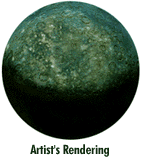A Pluto Primer
 Pluto
is the ninth planet from the Sun, and takes 248 years to complete an orbit.
It is the smallest planet in the solar system, with a diameter just two-thirds
the size of our Moon. Pluto has one satellite, Charon, though the pair orbit
in such a way that some astronomers consider them a double planet system.
Charon always keeps the same face to Pluto. And as it rotates, Pluto also
keeps the same face to Charon. To an observer on the planet, Charon remains
motionless in the sky -- there is no moonrise on Pluto.
Pluto
is the ninth planet from the Sun, and takes 248 years to complete an orbit.
It is the smallest planet in the solar system, with a diameter just two-thirds
the size of our Moon. Pluto has one satellite, Charon, though the pair orbit
in such a way that some astronomers consider them a double planet system.
Charon always keeps the same face to Pluto. And as it rotates, Pluto also
keeps the same face to Charon. To an observer on the planet, Charon remains
motionless in the sky -- there is no moonrise on Pluto.
Pluto most likely has a rock-ice core, a surface of methane ice, and a light atmosphere of nitrogen, carbon monoxide, and other pleasant gases. Compare this with the inner planets, Mercury, Venus, Earth and Mars, which are mostly rock with metal at the cores, or the gas giants, Jupiter, Saturn, Uranus and Neptune, made up largely of hydrogen and helium. Of the solid planets, Pluto has the lowest density, being about twice that of water.
And then there's its orbit. The majority of the planets have orbits which are nearly circular, while Pluto's ellipse is quite elongated.
Since it was discovered, Pluto has progressed through only one-fourth of its 248-year orbit. During its orbit, Pluto's distance from the Sun varies between 4,344 million kilometers and 7,400 million kilometers--the equivalent of 30 to 50 times the distance of the Earth to the Sun.
In fact, Pluto's path is so elongated -- so eccentric, to use the appropriate term -- it actually crosses the orbit of Neptune. For a brief 20 years of its orbit, Pluto is closer to the Sun than Neptune. This began in 1979, and ended in 1999, when Pluto regained its usual place in the solar system. While we still consider it the ninth planet, Pluto enjoyed temporary status as the honorary eighth planet.
Finally, Pluto's orbit shows a pronounced tilt relative to the plane of the solar system -- called the ecliptic -- in which the Earth orbits. It's true, the other planets' orbits are tilted a degree or two, that's to be expected. But Pluto's orbit is tilted a full 17 degrees to the ecliptic.
Pluto is not an easy planet to explain, and this book makes no attempt to account for, or defend, its existence. We'll just take a brief look at what's been learned about it, and how it was discovered. Suffice it to say that Pluto is indeed an oddity.